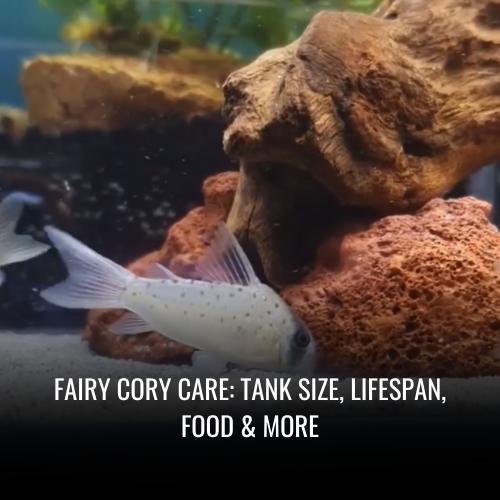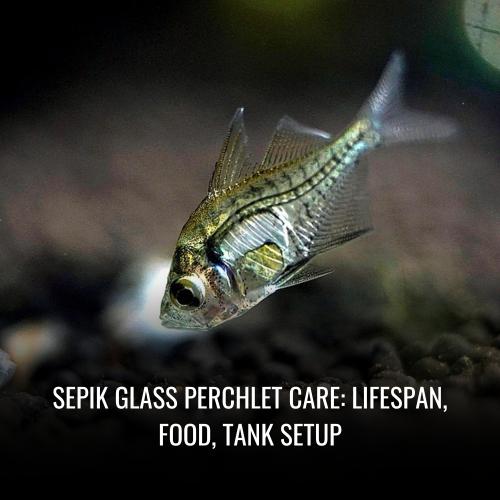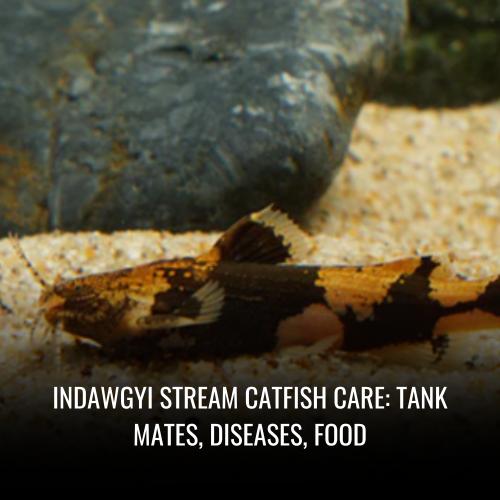Congo Ctenopoma, also known as the Banded Gourami, is a shy and intriguing fish species hailing from the diverse Congo River Basin of Africa. In the aquarium hobby, these fish are admired for their peaceful nature and unique breeding behaviors. Congo Ctenopoma thrives in well-established aquariums mimicking their native habitats—calm waters with dense vegetation and leaf litter providing gentle water movement and ample lines of sight.
Here’s a quick reference table summarizing the Congo Ctenopoma’s profile:
| Attribute | Information |
|---|---|
| Scientific name | Ctenopoma acutirostre |
| Common name | Congo Ctenopoma, Banded Gourami |
| Family | Anabantidae |
| Usual size in fish tanks | 4 to 6 inches |
| Recommended pH range | 6.7 to 7.7 |
| Recommended water hardness (dGH) | 4-22°N (71.43-392.86ppm) |
| Recommended temperature | 22 to 28°C (72-82°F) |
| Reproduction | Bubble nests created by males |
| Origin | Congo River basin in Africa |
| Temperament to its own species | Peaceful, with males showing parental care |
| Temperament toward other fish species | Peaceful, recommended to be housed with non-aggressive species |
| Usual place in the tank | Among dense vegetation and leaf litter, prefers gentle water movement |
| Lifespan | 5 to 8 years in captivity |
| Tank size requirement | At least 150 liters (40 US gallons) |
| Filtration system | Reliable filtration system |
| Sexual dimorphism | Subtle, females typically show a dark spot on their dorsal fin |
| Substrate cleaning | Required for optimal tank health |
When caring for these captivating fish, understanding and respecting their needs for specific water conditions and tranquil surroundings is imperative for a thriving Congo Ctenopoma.
Scientific Name
The Congo Ctenopoma, scientifically known as Ctenopoma kingsleyae, is an intricate member of the Anabantidae family, cherished among aquarium enthusiasts for its unique appearance and behaviors. This species takes its name from British explorer and ethnographer Mary Henrietta Kingsley, who is remembered for her significant contributions to West African studies.
In the aquarium trade, the Ctenopoma kingsleyae is often referred to as the Congo leaf fish or Congo bushfish, highlighting its excellent ability to blend into the dense aquatic foliage. Here is a quick summary:
| Scientific Name | Common Names | Family | Origin | Notable Feature |
|---|---|---|---|---|
| Ctenopoma kingsleyae | Congo Ctenopoma, | Anabantidae | Democratic Republic of Congo | Comb-like gill covers |
| Congo leaf fish, | (Congo River Basin) | |||
| Congo bushfish |
Understanding the etymology of Ctenopoma kingsleyae enriches the appreciation for its characteristics and history, bridging the gap between scientific inquiry and aquatic passion.
Average Size
The Congo Ctenopoma is a captivating medium-sized fish species, with adults generally measuring between 4 to 5 inches in length. This makes them a versatile choice for many aquarium enthusiasts, fitting comfortably in a variety of tank setups. It’s worth noting that while they average this size, under optimal conditions, some individuals can reach up to 6 inches, though this larger size is rarer in the confines of a home aquarium.
When introduced to an aquarium environment, juvenile Congo Ctenopomas are usually around 2 inches long. Prospective owners need to consider the growth potential and ensure their aquarium can accommodate a fully grown specimen.
| Size Category | Length in Aquarium |
|---|---|
| Juvenile | ~2 inches |
| Average Adult | 4-5 inches |
| Maximum Adult | Up to 6 inches |
Lifespan
The Congo Ctenopoma, celebrated for its relatively long lifespan among aquarium dwellers, averages an impressive 8-10 years in captivity. This period can extend with exemplary care, as some aquarists report these fish thriving well beyond the decade mark, highlighting their potential for longevity.
| Key Factors for Longevity | Recommendations |
|---|---|
| Stable Water Conditions | Regularly check & adjust as necessary |
| Low Stress Levels | Provide hiding spaces & dense vegetation |
| Well-Maintained Habitat | Include leaf litter & perform partial water changes |
| Balanced Diet | Offer a variety of frozen foods like blood worms and baby brine shrimp |
Natural Habitat
The Tailspot Ctenopoma is a remarkable fish species native to Africa, flourishing in environments such as the Congo River Basin, a haven of aquatic biodiversity. These fish are widespread across regions including the Democratic Republic of the Congo, Senegal, Guinea, and Mauritania. Notably, their presence in river basins like the Volta, Niger, and Congo underscores their ecological importance.
Here’s a glance at their natural habitat preferences:
| Habitat Feature | Role in Tailspot Ctenopomas Life |
|---|---|
| Gentle Water Movement | Mimics natural, slow-flowing streams |
| Dense Vegetation | Provides hiding and hunting grounds |
| Leaf Litter | Offers a natural substrate and refuge |
These conditions in the wild should be emulated in captivity to ensure the Tailspot Ctenopoma’s well-being, illustrating the species’ need for a habitat that echoes the quiet and sheltered waters of their African homes.
Appearance
The Congo Ctenopoma, also known as the African Leaf Fish, exhibits a captivating display of nature’s artistry. Its slender body, artfully painted in hues of mottled brown and green, is made even more striking by the iridescent blue spots that pepper its scalework. These shimmering spots catch the light and glisten, a feature that transforms the African Leaf Fish into a living jewel within an aquarium setting.
Distinctive markings on the Congo Ctenopoma include prominent opercular stripes, akin to the delicate brushstrokes of an artist. Moreover, a characteristic dark spot marks the commencement of the dorsal fin, further accentuating their visual intrigue. Here’s a quick overview of their notable features:
| Notable Appearance Features | Description |
|---|---|
| Coloration | Mottled brown and green with iridescent blue spots |
| Fins | Long and elaborate with intricate patterns and bright spots |
| Eye Position | High placement for enhanced observation |
| Opercular Stripes and Dark Spot | Prominent stripes and distinctive dark spot on the dorsal fin start |
Each element contributes to the Congo Ctenopoma’s breathtaking profile, making them a standout specimen in the aquarium hobby.
Behavior & Temperament
Congo Ctenopoma, often celebrated for their graceful appearance, surprisingly lean towards the shier side of the behavioral spectrum. They are primarily reclusive, favoring the shelter provided by dense vegetation and leaf litter, mimicking their natural habitat within the Congo River Basin. At night they become more animated, displaying nocturnal tendencies, which should be considered when planning their aquarium lighting to avoid undue stress.

Are Congo ctenopoma Fin Nippers?
Congo Ctenopoma are not typically known to be fin nippers. They coexist peacefully with many fish species and are not prone to aggressive behavior that involves nipping the fins of other aquatic denizens. Their peaceful nature makes them suitable for a communal tank, but it’s important to provide them with a habitat that includes dense vegetation and decor to ensure they feel secure.
Are Congo Ctenopoma Aggressive To Each Other & Other Fish?
While generally peaceful, Congo Ctenopoma can exhibit territorial tendencies—especially males during spawning—or when they feel threatened. Keeping them with suitable tankmates is key; small, tranquil species that occupy different strata within the aquarium are ideal. Ensuring a well-established aquarium with dense vegetation and multiple hiding spots will mitigate aggressive impulses and foster a serene communal life.
Are Congo ctenopoma Friendly To Each Other & Other Fish?
Congo Ctenopoma can interact amiably with one another and other fish once acclimated, often demonstrating curiosity. They synchronize well with peaceful species like Tetras, Rasboras, killifish, and Hatchet fish, which are ideal tankmates that do not impede on the Congo Ctenopoma’s need for calm. Establishing obscured lines of sight and plentiful retreats aids in reducing possible friction and heightens the chances for pleasant encounters.
Are Congo ctenopoma Schooling Fish?
Unlike typical schooling fish that display synchronized movement, Congo Ctenopoma do not form the tight, cohesive groups like Tetras or Rasboras. However, they may appreciate being in small numbers which can mimic natural pairings or groupings found in the wild, alleviating stress and encouraging their natural behavior in a well-crafted aquarium setting.
Can You Have Just One Congo Ctenopoma In The Tank?
While feasible, a single Congo Ctenopoma might face loneliness and heightened stress without companionship. To mitigate this, adding suitable tankmates and enriching the environment with ample hiding places is crucial. A solitary Congo Ctenopoma will require attentive care to ensure it does not succumb to reclusiveness, and thus, a decrease in well-being.
Do Congo Ctenopoma Need To Be In Groups?
Congo Ctenopoma are not mandatory group-dwellers, but they exhibit a natural preference for the company of their own kind, especially in pairs, which helps temper male aggression during breeding times. Groups can accentuate their behavior repertoire, which includes elaborate courtship displays and intriguing parental care, adding to the aquarium’s charm. However, an environment that enables them to establish personal territories is essential, as is providing several hiding spots that can prevent conflicts and encourage a harmonious group dynamic.
In conclusion, whether one intends to keep a lone Congo Ctenopoma or a small group, understanding their behavioral tendencies and environmental needs is paramount for creating a thriving aquatic display that showcases these shy yet fascinating fish at their best.
Food & Diet
Congo Ctenopoma are carnivorous fish with a strong preference for a protein-rich diet, embodying their dietary preferences in their natural Congo River habitat. A well-rounded feeding regime for these fish should include an array of live and frozen foods to meet their nutritional needs.
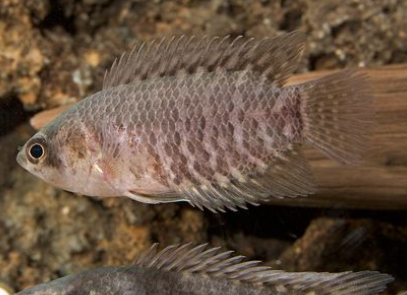
Do Congo Ctenopoma Eat Algae?
While Congo Ctenopoma might sporadically graze on algae within their aquarium, they are not to be relied upon as algae controllers. As carnivores, their diet in the wild and captivity primarily consists of meatier fare—algae is merely a supplemental nibble if that. To maintain their nutrition and health, their diet should be abundant in quality commercial foods and protein-rich live or frozen foods, with algae consumption considered incidental at best.
Do Congo Ctenopoma Eat Shrimp?
Shrimp constitutes an enticing meal for Congo Ctenopoma, resonating well with their wide-ranging carnivorous appetite. In the natural streams of the Congo River Basin, shrimp form a part of their diverse diet, and replicating this in an aquarium setting by offering live or frozen shrimp, such as baby brine shrimp, supplements their dietary needs admirably. Such variety in their diet not only provides nutritional balance but also encourages Congo Ctenopoma’s natural foraging behaviors.
Do Congo Ctenopoma Eat Bloodworms?
Bloodworms are a staple in the diet of Congo Ctenopoma—both live and frozen varieties. Serving as an excellent source of protein, bloodworms aid in fulfilling the fish’s nutritional requirements. Bloodworms’ similarity to the insect larvae found in their native habitat ensures they are a familiar and appealing food choice, beneficial to enhancing Congo Ctenopoma’s vibrant coloration and general health.
Do Congo Ctenopoma Eat Mosquito Larvae?
Indeed, mosquito larvae are among the preferred natural foods for Congo Ctenopoma, helping to simulate a more natural diet and control mosquito populations in the vicinity of the aquarium. Offering these larvae translates to an engaging, protein-rich treat that bolsters their vitality and closely mirrors their diet in the wild, effectively supporting their predatorily instinctual feeding habits.
Do Congo Ctenopoma Eat Planaria?
Planaria, a type of non-parasitic flatworm, can also feature in the diet of Congo Ctenopoma. Their consumption of planaria showcases their adaptability and predilection for a varied omnivorous diet. In a thriving aquarium, planaria can be a natural food source for these fish, integrating seamlessly into their diet and contributing to their health when part of a mixed dietary regime.
Do Congo Ctenopoma Eat Plants?
Contrary to what one might expect, Congo Ctenopoma do not usually target plants as a food source. Soft plant leaves might occasionally be nibbled on, but such behavior is not characteristic of these carnivorous fish. Their inclinations lean toward a meat-based diet abundant in invertebrates and similar fare, rather than vegetative substances. For the health and satisfaction of Congo Ctenopoma, a diet rich in animal proteins is recommended over a reliance on plant matter.
Sexing: Male vs Female
Identifying the gender of Congo Ctenopoma can be straightforward if you know what to look for. The visual differences between males and females are most notable during the breeding season.
Males:
- Longer Fins: Their dorsal and anal fins are more extended and intricately shaped.
- Coloration: A vibrant red or orange tinge is often present on the fins.
- Brighter Body: The body coloration may display greater intensity and saturation.
- Nodules: Small, conical protrusions may develop on the front rays of the pectoral fins.
- Size: Generally, they grow slightly larger than females upon reaching sexual maturity.
Females:
- Fins: Shorter and less ornate dorsal and anal fins.
- Coloration: Lack the distinctive hues of their male counterparts, presenting more subdued tones.
- Size: On average, exhibit a slightly smaller stature.
By observing these distinct characteristics, especially the fin length and coloration, aquarists can differentiate male Congo Ctenopoma from females, which is essential for breeding purposes or simply understanding the social dynamics within the aquarium community.
Congo ctenopoma Tank Mates
Congo ctenopomas, with their timid nature, flourish in community aquariums that offer both safety and comfort. To enhance their confidence, ideal tankmates include Tetras, Rasboras, Killifish, and Hatchet fish. These companions not only make for a dynamic tank but also prevent the ctenopomas from feeling exposed. It is, however, crucial to avoid pairing them with very small fish or fry, which they might mistake for food due to their larger size and occasional boldness in feeding.
For the benefit of all species, maintain pristine water conditions. Regular, small water changes help manage nitrate levels, keeping the tank healthy and the residents active. An optimal setup encourages visibility, allows each species to display their natural behaviors, and keeps your Congo ctenopomas content and sociable.
Ideal Tankmates for Congo Ctenopomas
- Tetras: Support visibility and add movement.
- Rasboras: Peaceful and enhance tank dynamics.
- Killifish: Share similar water condition preferences.
- Hatchet fish: Provide upper tank activity and interest.
Tank Conditions to Avoid
- Tiny Fish/Fry: Risk of becoming prey.
- Aggressive Species: Can stress out Congo ctenopomas.
Aquarium Setup
- Substrate: Dark-colored for comfort.
- Vegetation: Dense, with floating plants for security.
- Hideouts: Driftwood and smooth rocks for shelter.
- Water Movement: Gentle, with efficient filtration.
- Water Changes: Regularly, to maintain low nitrate levels.
Aquarium Setup
Congo ctenopomas, also known as Spotted ctenopomas or Ctenopoma acutirostre, are an intriguing fish species that originate from the lush waterways of the Congo River Basin. These shy yet captivating creatures are a fascinating addition to the aquarium hobby, but their contentment relies on a carefully crafted habitat that closely mirrors their natural environment.
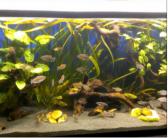
Ideal Tank Size
When selecting an aquarium for Congo ctenopomas, size is of utmost importance. A minimum tank size of 90x40x40 cm (approximately 30 gallons) is necessary to accommodate the fish’s need for swimming room as well as their labyrinth organ—an organ that allows them to breathe atmospheric air. A larger space, 50 gallons or more, is highly recommended.
Not only does this provide ample room for them to establish territories, but it also enables the aquarist to create a harmonious aquascape with dense vegetation and numerous hiding spots that are essential for their comfort. Additionally, always ensure there is at least 2.5 cm of air space above the water’s surface to support the fish’s labyrinth breathing.
Ideal Water Parameters
Water conditions are critical for the health and longevity of Congo ctenopomas. These fish thrive in freshwater that falls within a pH range of 6.0 to 8.0, with a recommended range of 6.2 to 7.2 for optimal conditions. Water hardness should be moderate, between 5 to 15 degrees GH, and temperatures should be maintained between 75°F to 82°F (24°C to 28°C). Maintaining these parameters will not only assure the well-being of the Congo ctenopomas but will also support a vibrant ecosystem within the aquarium.
Filtration
Clean water is life-sustaining for all aquarium inhabitants, but it is particularly significant for Congo ctenopomas, who are very sensitive to impurities. An efficient filtration system must be in place to manage waste and keep nitrate levels low. A combination of mechanical, biological, and chemical filtration is the most effective approach to maintaining pristine water conditions.
roper and regular maintenance of the filtration system, such as cleaning and timely replacement of the filter media, is essential to prevent the buildup of harmful substances that could jeopardize the health of the Congo ctenopomas.
Lighting
Congo ctenopomas are accustomed to subdued lighting, reflective of the shaded streams and dense canopies of their natural habitat. In the aquarium, this is best emulated with moderate lighting options, such as the use of floating plants to cast gentle shadows or the deployment of dimmable LED lights.
Ensure that the lighting is not overly bright, as this can lead to undue stress for these secretive fish. A well-adapted lighting system is also beneficial for maintaining plant health and simulating a natural day-night rhythm, further enhancing the Congo ctenopomas’ living conditions.
Common Possible Diseases & Prevention
Congo ctenopomas are not immune to the ailments that befall many freshwater aquarium fish. Notably, ich, characterized by white spots on the skin and gills, and fin rot, an unsightly decay of the fin edges, pose significant threats. Additionally, parasitic infections like the velvet disease, yielding a dusty coating on the fish’s body, and bacterial infections can occur, especially when stress is prevalent or water quality declines.
Prevention is key in ensuring the health of Congo ctenopomas. Here’s a concise list of preventative measures:
- High Water Quality: Implement regular water changes and monitor nitrate levels.
- Balanced Diet: Offer a variety of foods, including frozen foods like baby brine shrimp and blood worms, to bolster their immune system.
- Stress Reduction: Choose suitable tankmates that are non-aggressive and maintain a peaceful environment.
- Quarantine New Arrivals: Prevent the introduction of pathogens by isolating new fish before adding them to the main tank.
A diligent aquarist will also keep a vigilant eye on their fish’s behavior and appearance, swiftly addressing any signs of distress. This proactive approach helps prevent diseases from taking hold in a well-established aquarium.
Breeding Congo ctenopoma In Aquarium
Breeding the shy and captivating Congo ctenopoma in an aquarium setting can be both rewarding and fascinating. To start, aquarists should provide plenty of hiding spots with plants and driftwood, creating a safe and secure environment for the spawning pair. These accommodations help mimic the dense vegetation found in their natural habitat within the Congo River Basin.
For those aiming to stimulate breeding, it’s essential to adjust the aquarium conditions. Ensure there is gentle water movement and that temperatures are slightly elevated but still within their comfortable range. Table: Breeding Conditions
| Condition | Requirement |
|---|---|
| Water Movement | Gentle |
| Temperature | Slightly elevated within safe range |
| Environment | Ample hiding spots, plants, driftwood |
Once successful, the hatchlings, or fry, will require proper nutrition. Initial feeds should consist of microscopic organisms like baby brine shrimp and microworms, catering to their diminutive size. With attentive care, aquarists can witness the full cycle of life for these enchanting fish, from bubble nests to darting fry.
Are Congo ctenopoma Easy To Keep?
Congo ctenopoma, also known as Ctenopoma kingsleyae, are relatively easy to keep, especially within a well-established aquarium featuring appropriate water conditions and sheltering decor. These fish flourish in a setting that replicates their native environment in the Congo River Basin—a complex ecosystem composed of the Congo River and its tributaries like the Lualaba and Upemba Rivers.
These fish prefer dimly lit conditions, which can be readily provided by employing subdued lighting or by adding a canopy of floating plants to diffuse light. This, combined with efficient filtration and gentle water movement, reproduces the tranquil and shadowy environment of their natural habitat. Additionally, regular small, frequent partial water changes contribute to the stable water quality that these fish require.
| Water Condition | Requirement |
|---|---|
| Ammonia | Near 0 ppm |
| Nitrate Levels | Low |
| pH | 6.0-7.5 (Slightly acidic preferred) |
| Temperature | 75-80°F (approx. 24-27°C) |
| Water Hardness | Soft to moderately hard |
| Water Movement | Gentle |
For new aquarists, ease of care is amplified by replicating these conditions, which helps in maintaining the health and vibrancy of the Congo ctenopoma.
Are Congo ctenopoma Sensitive To Water Changes?
Congo ctenopoma show a certain sensitivity to sudden and drastic shifts in water conditions. Stability is key for the health of these fish, as oscillations in temperature or pH can induce stress, potentially leading to health complications. Regular, small changes are far more appropriate for this species, facilitating a controlled adjustment period.
To consistently protect the Congo ctenopoma from the adverse effects of water parameter fluctuations, aquarists need to establish a regular testing and adjustment routine, ensuring that the water parameters stay within an ideal range:
| Water Parameter | Ideal Range |
|---|---|
| pH | 6.0 to 7.5 |
| Temperature | 75-80°F (approx. 24-27°C) |
| Water Hardness | Soft to moderately hard |
This care does not only support their well-being but also aids in their natural behavior, ensuring their environment remains as consistent as possible with their native aquatic landscapes in the Democratic Republic of Congo.
Are Congo ctenopoma Sensitive To Ammonia?
Indeed, Congo ctenopoma are highly susceptible to the deleterious effects of ammonia. Ammonia arises from organic matter decay, food remnants, and fish excretions, all of which are toxic to Congo ctenopoma. Even in small amounts, ammonia can impair their immune systems, making these fish more prone to disease. It can also reduce their ability to efficiently use oxygen, causing signs of distress, such as lethargy.
Maintaining pristine water conditions is thus non-negotiable. A rigorous biological filtration system is indispensable for continuous removal of ammonia, as is regular water testing to promptly detect and correct any rise in ammonia levels. The following practices are key to manage ammonia sensitivity:
- Avoid overfeeding to reduce waste
- Perform regular tank maintenance
- Establish a balanced and mature biological filter
Are Congo ctenopoma Sensitive To Copper?
Congo ctenopoma exhibit a pronounced sensitivity to copper, a metal that is sometimes found in tap water and certain aquarium medications. Even minute amounts can be harmful, causing respiratory distress and affecting the regulatory function of the fish’s mucous membranes. High copper concentrations can be lethal, inducing severe health issues and increasing the risk of mortality.
Aquarists must exercise caution when introducing any substance that may contain copper, such as certain treatments or fixtures like pipes that may leach the metal into the aquarium. To ensure the safety of these fish:
- Use copper-free treatments and medications when necessary
- Regularly test water for trace copper levels
- Opt for copper alternative materials in aquarium setup
Maintaining a copper-free environment will contribute significantly to the health and lifespan of Congo ctenopoma, enabling them to thrive in captivity.

